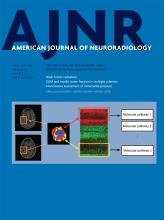Article Figures & Data
Tables
- Table 1:
Demographic and clinical characteristics of the study subjects according to the MRI scanner changes between the index and postindex periodsa
Index Variables Total Patients with RRMS (n = 590) Patients with RRMS with MRI Scanner Changes (n = 309) Patients with RRMS without MRI Scanner Changes (n = 281) P Valueb Age at index in yr (median) (IQR) 42 (36; 49) 41 (35; 48) 44 (37; 51) .007 Women (No.) (%) 464 (78.6) 247 (79.9) 217 (77.2) .422 Race/ethnicity (No.) (%) Caucasian/white 494 (83.7) 252 (81.6) 242 (86.1) .319 Non-Caucasian 63 (10.7) 37 (12.0) 26 (9.3) Unknown 33 (5.6) 20 (6.5) 13 (4.6) Body mass index at index (median) (IQR) 26.6 (23.2–30.6) 26.5 (23.3–30.4) 26.6 (23–30.9) .895 Disease duration in yr (median) (IQR) 8 (4; 13) 7 (4; 12) 8 (4; 13) .148 Number with relapse in 2 yr before index (No.) (%) 236 (40.0) 143 (46.3) 93 (33.1) .003 EDSS at index (median) (IQR) 2.0 (1.0–3.0) 2.0 (1.0–3.0) 2.5 (1.5–3.5) .002 Use of DMT 2 yr before index (No.) (%) Teriflunomide 5 (0.9) 3 (1) 2 (0.7) .749 Glatiramer acetate 175 (30.8) 87 (28.9) 88 (32.8) .310 Interferon-β 317 (55.7) 175 (58.1) 142 (53) .217 Alemtuzumab 1 (0.2) 1 (0.3) 0 (0) .345 Dimethyl fumarate 38 (6.7) 21 (7) 17 (6.3) .763 No DMT 94 (15.9) 46 (14.9) 48 (17.1) .467 Note:—EDSS indicates Expanded Disability Status Scale; IQR, interquartile range; DMT, disease-modifying treatment.
↵a MRI changes include hardware/software/coil/protocol differences between the index and postindex.
↵b P values represent group comparisons of patients with MS with and without MRI changes during the follow-up derived with the Student t, χ2, and Mann-Whitney rank sum tests as appropriate.
- Table 2:
Brain atrophy measures of the study subjects between index and postindex, according to MRI changesa
Total Patients with RRMS Patients with RRMS with MRI Software/Coil/Protocol Changes Patients with RRMS without MRI Software/Coil/Protocol Changes P Valueb PBVC on 2D-T1WI n = 259 n = 89 n = 170 .233 −0.31 (−0.74–0.13) −0.35 (−0.97–0.11) −0.28 (−0.67–0.14) PBVC on 3D-T1WI n = 110 n = 37 n = 73 .740 −0.38 (−0.88 to −0.04) −0.38 (−0.93–0.02) −0.37 (−0.81 to −0.08) PLVVC on 2D-T1WI n = 257 n = 89 n = 168 .848 0.95 (−1.77–3.99) 0.95 (−1.92–4.1) 0.96 (−1.63–3.94) PLVVC on 3D-T1WI n = 110 n = 37 n = 73 .940 1.47 (−1.26–4.39) 1.5 (−1.36–4.15) 1.01 (−1.17–4.46) PLVVC on T2-FLAIR n = 388 n = 130 n = 258 .179 0.90 (−2.91–5.94) 0.21 (−4.67–7.2) 1.1 (−2.1–5.51) PLVVC on T2-FLAIRc n = 554 n = 291 n = 263 .007 0.51 (−3.95–6.01) −0.31 (−6.4–6.9) 1.13 (−2.15–5.53) ↵a PBVC and PLVVC on 2D-, 3D-T1WI and T2-FLAIR were obtained in patients with software/coil/protocol scanner changes. All values in the table are presented as the number of patients for a particular analysis, median, and interquartile range. The longitudinal follow-up values are annualized.
↵b P values represent patients with MS with and without MRI changes during the follow-up group comparisons and were derived using analysis of covariance adjusted for age, sex, days between index and postindex, and baseline volume as appropriate.
↵c PLVVC on T2-FLAIR was performed in patients with hardware/software/coil/protocol changes.












